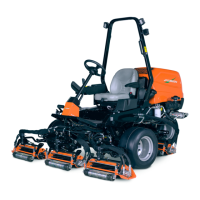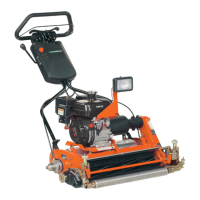HYDROSTATIC POWER TRAIN
4203781 First Edition 5-45
5
Right Rear Wheel Motor Test
38. Open flow meter valve completely before starting
engine.
Figure 5-41: Right Rear Wheel Motor Test—All
Wheels Restrained
NOTE
Verify engine rpm is within specification (2800 rpm ± 50)
to ensure accurate hydraulic test results.
39. Start engine, release park brake, and run at full
throttle (2800 rpm ± 50).
40. Adjust flow lock tool (7) to allow pump to produce 15
gpm (57 lpm) in the forward direction.
41. Use the flow meter to warm the hydraulic oil. Turn the
flow meter valve until a reading of 1750 psi (121 bar)
or one half of the relief valve rating is reached. Warm
oil to 120–150° F (49–65° C); open valve fully after
operating temperature is reached.
42. After warming the hydraulic oil, verify flow lock tool is
adjusted to allow pump to produce 15 gpm (57 lpm)
in the forward direction.
43. Engage 4WD switch in the forward position.
44. Slowly close flow meter valve until pressure reaches
2625 psi (181 bar). Read and record loaded flow.
45. Open flow meter valve, stop engine, and set park
brake. Return flow lock tool back to neutral position.
46. Calculate right rear wheel motor leakage.
(Step 34 – Step 44 / Step 34 x 100 = Leak
Percentage)
Is right rear wheel motor leakage 10% or less?
YES The right rear wheel motor is good. Proceed
to step 47.
NO Proceed to next question.
Is right rear wheel motor leakage 11% to 20%?
YES The right rear wheel motor is marginal.
Repair or replace right rear wheel motor as
necessary. Continue to step 47.
NO Proceed to next question.
Is right rear wheel motor leakage 21% or more?
YES Repair or replace right rear wheel motor.
(See “Rear Wheel Motor” on page 5-64.)
Continue to step 47.
47. Disconnect and remove test equipment. Install all
hoses and fittings as noted prior to removal.
48. Install and connect all components as noted prior to
test.
49. Check hydraulic oil level. Add oil as needed. (Refer to
“Safety, Operation, and Maintenance Manual” for oil
specifications.)
TN2344

